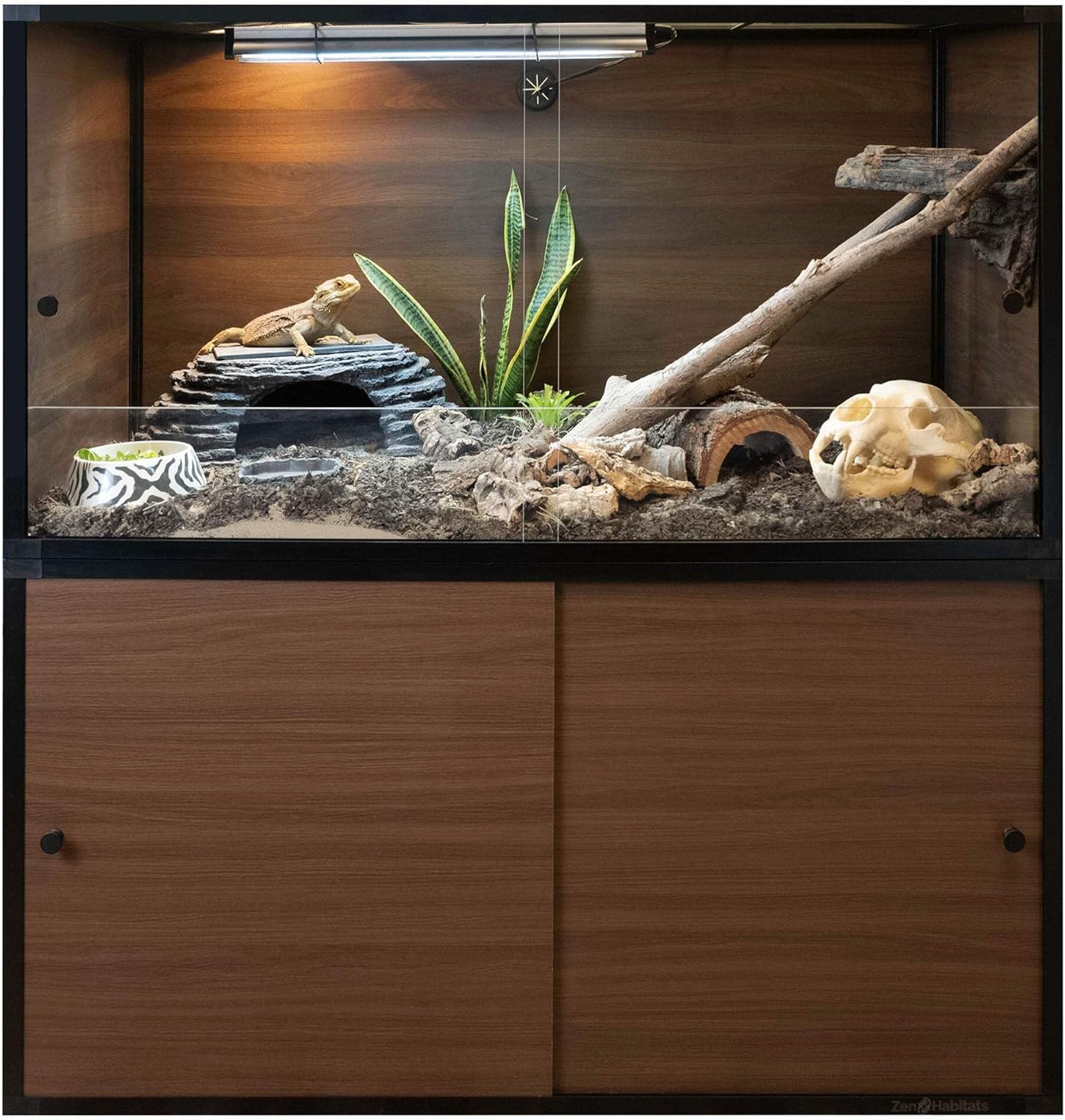Creating a proper bearded dragon enclosure isn’t just about aesthetics—it’s about health, enrichment, and longevity. At Nexus Morphs, we’ve built hundreds of reptile habitats, and one principle always holds true: the enclosure is the foundation of your dragon’s well-being.
Whether you’re building from scratch or upgrading, this guide will help you choose the right size, materials, layout, and supplies to create a professional-grade setup your dragon can thrive in.
Enclosure Size and Space Requirements
Size is the first decision—and the most important. A cramped environment limits movement, stunts behavior, and affects thermoregulation.
Recommended minimum dimensions:
-
Juveniles: 3′ L × 1.5′ W × 1.5′ H
-
Adults: 4′ L × 2′ W × 2′ H (or larger)
If you can go bigger, do it. A larger enclosure allows for a more natural temperature gradient, deeper substrate, climbing décor, and space for enrichment items like rocks and hides.
Avoid small glass tanks. Anything under 40 gallons is too small beyond the hatchling stage.
2. Best Materials for Bearded Dragon Enclosures
The material of your enclosure affects insulation, humidity, cleaning, and safety.
Top Choices:
-
PVC (Polyvinyl Chloride): Lightweight, durable, and retains heat efficiently. Easy to clean.
-
HDPE or ABS Plastic: Similar to PVC with higher durability; resists scratching and moisture.
-
Sealed Plywood or Melamine: Excellent for DIY builds, but must be properly sealed to prevent mold.
-
Glass: Great visibility but poor heat retention; works best in warm, dry climates with consistent room temperature.
Avoid cheap particle board—it warps, absorbs moisture, and harbors bacteria.
Some of our favorite enclosure are:
-
Zen Habitats 4' x 2' x 2' Reptile Enclosure 3.0
-
REPTI ZOO 4' x 2' x 2' Reptile Tank Terrarium
3. Enclosure Layout & Zoning
Think of your enclosure like a miniature ecosystem. A proper layout includes zones for basking, cooling, hiding, and exploration.
Basking Zone
-
Position heat lamps above a solid surface (stone, tile, or cork).
-
Maintain a basking surface temperature of 95-105°F for adults and 100-110°F for juveniles.
-
Use an accurate thermostat controlled heat zone.
Cool Zone
-
Place hides, plants, and shade décor on the opposite end.
-
Keep ambient temps between 75–85°F during the day, 70–75°F at night.
Climbing & Enrichment
-
Include sturdy branches, cork bark, or stacked stones.
-
Avoid lightweight items that could tip or shift when your dragon climbs.
4. Ventilation & Lighting
Every enclosure setup needs adequate airflow without sacrificing heat retention. Mesh tops or side vents help prevent stagnant air, especially in PVC builds.
Lighting is equally crucial:
-
Use a T5 HO 10% UVB bulb that spans at least two-thirds of the enclosure length.
-
Mount the UVB inside the enclosure (not on top of the mesh) for maximum penetration. We use the Solarmeter Model 6.5R Reptile UV Index Meter.
-
Replace UVB bulbs every 12 months or as manufacturer recommends.
-
Supplement with a full-spectrum LED light bar to enhance visibility and natural color.
5. Substrate and Flooring
Substrate affects health, hygiene, and natural behavior. Choose one that fits your goals.
Best for naturalistic setups: packed fine sand/soil mixes or commercial desert substrates (4–6″ deep).
Simpler options: slate tile, excavator clay, or sealed surfaces for easy cleaning.
Avoid: calcium sand, reptile carpet, wood chips, and nut shells—they pose health risks.
For detailed options, read the Nexus Morphs Bearded Dragon Substrate Guide.
6. Décor & Functional Supplies
Décor provides both utility and enrichment. A well-designed habitat uses décor strategically—not just decoratively.
Essentials:
-
Basking Spot with a hide
-
Hide on both warm and cool sides
-
Climbing branches
-
Non-toxic live or artificial plants (warning, artificial plants might get eaten)
-
Background or foam wall for texture or a hammock for climbing
-
Food dish for greens
-
Dubia roach escape-proof feeder
-
Water dish for drinking, soaking, and play
-
Thermostat with dimming and pulse proportional control
7. Cleaning and Maintenance
Routine maintenance keeps your enclosure healthy and odor-free:
-
Daily: Remove waste and uneaten food.
-
Weekly: Wipe surfaces, clean bowls, inspect décor.
-
Monthly: Deep clean substrate and disinfect with reptile-safe products.
-
Annually: Replace UVB bulb, inspect wiring and seals.
8. Common Enclosure Mistakes to Avoid
-
Using a tank that’s too small for adults.
-
Using heating mats instead of basking bulbs.
-
Relying on colored bulbs for heat (they disrupt circadian rhythm).
-
Using carpet or calcium sand substrates.
-
Placing lights too far from the basking surface or outside the tank.
-
Ignoring ventilation in solid-walled builds.
Final Thoughts
Your bearded dragon’s enclosure defines every part of its health and behavior. The best habitat is spacious, stable, and natural—built around your dragon’s biology, not convenience.
When in doubt, overbuild. Provide more space, better light, and safer substrate than you think you need. A dragon that can move, dig, and explore is a healthy, long-lived pet.

Share:
Bearded Dragon Substrate & Housing: Choosing the Right Bedding for Your Setup
Bearded Dragon Feeding Guide: Complete Diet, Schedule, and Supplements